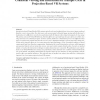Free Online Productivity Tools
i2Speak
i2Symbol
i2OCR
iTex2Img
iWeb2Print
iWeb2Shot
i2Type
iPdf2Split
iPdf2Merge
i2Bopomofo
i2Arabic
i2Style
i2Image
i2PDF
iLatex2Rtf
Sci2ools
CGF
2007
2007
Consistent Viewing and Interaction for Multiple Users in Projection-Based VR Systems
In projection-based Virtual Reality (VR) systems, typically only one headtracked user views stereo images rendered from the correct view position. For other users, who are presented a distorted image, moving with the first user’s head motion, it is difficult to correctly view and interact with 3D objects in the virtual environment. In close-range VR systems, such as the Virtual Workbench, distortion effects are especially large because objects are within close range and users are relatively far apart. On these systems, multi-user collaboration proves to be difficult. In this paper, we analyze the problem and describe a novel, easy to implement method to prevent and reduce image distortion and its negative effects on close-range interaction task performance. First, our method combines a shared camera model and view distortion compensation. It minimizes the overall distortion for each user, while important user-personal objects such as interaction cursors, rays and controls remain ...
Related Content
| Added | 12 Dec 2010 |
| Updated | 12 Dec 2010 |
| Type | Journal |
| Year | 2007 |
| Where | CGF |
| Authors | Gerwin de Haan, Rene Molenaar, Michal Koutek, Frits H. Post |
Comments (0)

